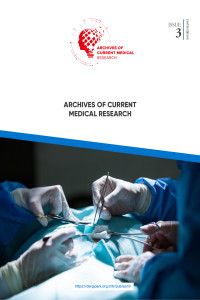Evaluation of patients who received erythrocyte transfusion in the emergency department
Evaluation of patients who received erythrocyte transfusion in the emergency department
Anemia, Emergency Erythrocyte Transfusion.,
___
- 1. Hare GMT, Cazorla-Bak MP, Ku SFM, Chin K, Mistry N, Sklar MC et al. When to transfuse your acute care patient? A narrative review of the risk of anemia and red blood cell transfusion based on clinical trial outcomes. Can J Anaesth. 2020;67:1576-94.
- 2. American Red Cross. A Compendium of Transfusion Practice Guidelines Edition 4.0. 2021. Available at: https://www. redcrossblood.org/content/dam/redcrossblood/hospital-pagedocuments/ 334401_compendium_v04jan2021_bookmarkedworking_ rwv01.pdf Accessed September 20, 2021
- 3. World Health Organization. Haemoglobin concentrations for the diagnosis of anaemia and assessment of severity. 2011. Available at: https://www.who.int/vmnis/indicators/haemoglobin.pdf Accessed May 20, 2020.
- 4. Yaddanapudi S, Yaddanapudi L. Indications for blood and blood product transfusion. Indian J Anaesth. 2014;58:538-42.
- 5. Carson JL, Guyatt G, Heddle NM, Grossman BJ, Cohn CS, Fung MK et al. Clinical Practice Guidelines From the AABB: Red Blood Cell Transfusion Thresholds and Storage. JAMA. 2016;316:2025-35.
- 6. Goodnough LT, Levy JH, Murphy MF. Concepts of blood transfusion in adults. Lancet. 2013:381:1845-54.
- 7. Serious Hazards of Transfusion (SHOT) Working Expert Group. Annual SHOT Report. 2018. Available at: https://www.shotuk.org/ wp-content/uploads/myimages/SHOT-Report-2018_Web_Version-1. pdf Accessed May 21, 2020.
- 8. Maxwell MJ, Wilson MJA. Complications of blood transfusion. Continuing Education in Anaesthesia Critical Care & Pain 2006:6;225-9.
- 9. Franchini M, Marano G, Mengoli C, Pupella S, Vaglio S, Muñoz M et al. Red blood cell transfusion policy: a critical literature review. Blood Transfus. 2017;15:307-17.
- 10. Dugdale M. Anemia. Obstet Gynecol Clin North Am. 2001;28:363-81.
- 11. Vásquez-Velásquez C, Gonzales GF. Situación mundial de la anemia en gestantes [Global situation of anemia in pregnant women]. Nutr Hosp. 2019;36:996-7.
- 12. Teshale AB, Tesema GA, Worku MG, Yeshaw Y, Tessema ZT. Anemia and its associated factors among women of reproductive age in eastern Africa: A multilevel mixed-effects generalized linear model. PLoS One. 2020;15:e0238957.
- 13. Boureau AS, de Decker L. Blood transfusion in older patients. Transfus Clin Biol. 2019;26(3):160-163.
- 14. Mueller MM, Van Remoortel H, Meybohm P, Aranko K, Aubron C, Burger R, et al. Patient Blood Management: Recommendations From the 2018 Frankfurt Consensus Conference. JAMA. 2019;321(10):983- 997.
- 15. Levent A, Köse Ö, Linke P, Gehrke T, Çıtak M. Does tourniquet use decrease blood loss following primary total knee arthroplasty in Jehovah’s Witness patients? Jt Dis Relat Surg. 2020;31(3):419-425.
- 16. Wang JK, Klein HG. Red blood cell transfusion in the treatment and management of anaemia: the search for the elusive transfusion trigger. Vox Sang. 2010;98:2-11.
- 17. Bıçakçı Z, Olcay L. Citrate metabolism and its complications in non-massive blood transfusions: association with decompensated metabolic alkalosis+respiratory acidosis and serum electrolyte levels. Transfus Apher Sci. 2014;50:418-26.
- Yayın Aralığı: Yılda 3 Sayı
- Başlangıç: 2020
- Yayıncı: 14 Mart Tıbbiyeliler Derneği
Evaluation of patients who received erythrocyte transfusion in the emergency department
Telemedicine/telehealth in Preventive Medicine
Burçin YILDIRIM, Muhammed Mustafa UZAN, Memet Taşkın EGİCİ
Something is still wrong: Epinephrine use in venom immunotherapy patients
Gökhan AYTEKİN, Fatih ÇÖLKESEN, Eray YILDIZ, Şevket ARSLAN, Ahmet ÇALIŞKANER
Mustafa YERLİ, Ali YÜCE, Tahsin Olgun BAYRAKTAR, Niyazi İĞDE, Bulent KARSLIOGLU, Nazım ERKURT, Mustafa Buğra AYAZ, Süleyman Semih DEDEOĞLU, Yunus İMREN, Hakan GÜRBÜZ
Prognostic factors after pneumonectomy in non-small cell lung cancer
Cemal AKER, Celal Buğra SEZEN, Mustafa Vedat DOĞRU, Ali Murat AKÇIL, Umut KİLİMCİ, Semih ERDUHAN, Levent CANSEVER, Muzaffer METİN
Alim Can BAYMURAT, Mesut TAHTA, Nazmi UYSAL
Patients with third degree burns in an emergency department
Tamer DURDU, Ahmet Burak ERDEM, Elif ÇELİKEL, Selahattin GÜRÜ, Alp ŞENER
Predictive role of NLR, SII, and PLR in COVID-19 patient mortality and disease severity
Ayşegül İnci SEZEN, Kadriye KART YAŞAR
Muhammed Çağatay ENGİN, Mehmet KÖSE, Serdar TOY, Mehmet Cenk TURGUT
Mustafa Vedat DOĞRU, Celal Buğra SEZEN, Cemal AKER, Fatma TOKGÖZ AKYIL, Muzaffer METİN
